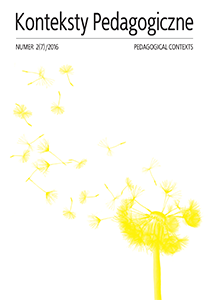Abstract
Development-focused diagnostics and therapy of articulatory skills de-viations in children of pre-school age and at the start of school attendance shows a significant preventive and stimulatory potential in this area, which has long been marked by persistent obsolete and unfounded claims and methods. This fact is in ac-cordance with the requirement for qualified speech therapy care to develop effective focus of preventive and intervention measures, depending on the development of the field, as well as the conditions and environment in current society. In the Czech Republic, a stable number of children, slightly rising rather than decreasing (around 40%) enter elementary school with persisting deviations of articulation develop-ment.21 These conclusions are not in agreement with the aforementioned claim about the necessity (and practical implementation) of articulatory deviation adjustments before the beginning of compulsory school attendance. The above mentioned fact is surprisingly linked with a limited development of findings on the ideal intervention tactic for adjusting articulation deviations in children at the start of their school years, even though in practice this is a very frequent phenomenon, including the issue of linking the phoneme to the grapheme with a specific phone and an adequate level of cooperation with the school programme. This fact can be, without exaggeration, called an indicator of a limited efficiency of care about children’s articulation and a trigger mechanism producing lasting deviations of pronunciation, and therefore it is necessary to support this fact by presenting results of research studies. The studies presented prove the above stated conclusions and point to the current deficiency of expert speech therapy care in preschools, and especially in elementary schools. The solution is to apply a targeted preventive programme of children’s articulation skills development and to support those forms of speech therapy intervention that build on the establishment of a long-term, responsible therapeutic relationship between the therapist, the child and its family. The fact that in the period of what we call physi-ological articulatory deviations mechanisms appear and become fixed, which lead to the production of deviations from intact articulation, leads to criticisms of using the term “physiological dyslalia” and to underscoring the need for timely preventive stimulation already since the child is 2,5–3 years old.
References
Bernthal J., Bankson N., Flipsen P., Articulation and Phonological Disorders. Speech Sound Disorders in Children, Boston 2009.
Guthová M., Dyslália, [in:] Základy logopédie,ed. A.Kerekrétiová, Bratislava 2009.
Guthová M., Šebianová D., Terapie dyslalie, [in:] Terapie narušené komunikační scho-pnosti, ed. V. Lechta, Praha.
Hanušová Š., Řečové vady u dětí předškolního věku (Diplomová práce, Katedra SPP, Pedagogická fak. UHK), Hradec Králové 2007.
Neubauer K., Artikulace a fonologické rozlišování hlásek,Havl. Brod 2011.
Neubauer K., Hodnota a význam vývojově zaměřené diagnostiky a terapie odchylek artikulačních schopností u dětí předškolního věku a v počátku školní docházky, [in:] Jinakost ve speciálněpedagogickém kontextu, ed. J. Huritová, Olomouc 2014.
Neubauer K., Logopedie a surdologopedie, Hradec Králové 2014.
Neubauer K., Vondráčková V., Vývoj artikulace a řečových schopností u dětí v počátku školní docházky, opomíjené a zásadní téma české logopedie, [in:] Komunikace a handi-cap II, eds. K. Neubauer, M. Kaliba, Hradec Králové 2014.
Neubauer K., Vondráčková V., Paštiková J., Zaplatílková M., Odchylky vývoje artikulačních schopností u dětí v předškolním a školním věku, [in:] Kontexty vývojových poruch řečové komunikace a specifických poruch učení, eds. K. Neubauer, S. Tübele a kol., Hradec Králové 2015.
Novotná S., Frekvence a výskyt řečových poruch u dětí při zápisu do ZŠ (Diplomová práce, Katedra SPP, Pedagogická fak. UHK), Hradec Králové 2010.
Palková Z., Fonetika a fonologie češtiny, Praha 1994.
Půstová Z., Zpráva o průzkumu správné výslovnosti u žáků prvních ročníků ZŠ v roce 1999/2000, [in:] Diagnostika a terapie poruch komunikace, Praha 2001.
Sovák M., Logopedie předškolního věku,Praha 1984.
Vyštejn J., Vady výslovnosti, Praha 1979.
In accordance with the recommendation of the Ministry of Science and Higher Education, which aims to counteract the practice of “ghostwriting” and “guest authorship,” all authors submitting their text for publication should attach an author’s statement which declares the contribution of each of the authors to the article. The printed and signed statement should be delivered by mail or other means to editor-in-chief Joanna Skibska or sent in the form of a scan to the following e-mail address: redakcja@kontekstypedagogczne.pl. The authors will not receive remuneration for publishing their papers. The editors reserve the right to make minor editorial changes to the articles which will not affect the substance of the article. We encourage all authors to prepare their articles in accordance with the guidelines for manuscript preparation. Download pdf file.
Authors transfer all copyrights and grant the journal the right of first publication with the work simultaneously licensed under a Creative Commons Attribution License that allows others to share the work with acknowledgement of the work's authorship and initial publication in this journal. All authors agree to the publishing of their email addresses, affiliations and short bio statements with their articles during the submission process.

